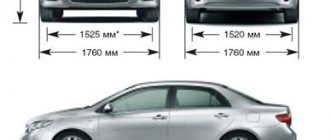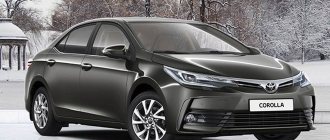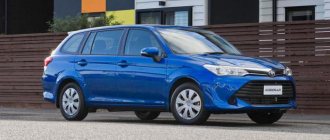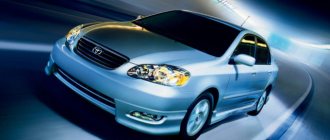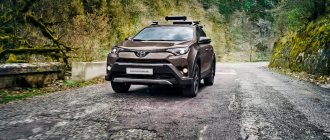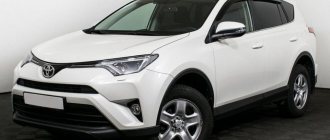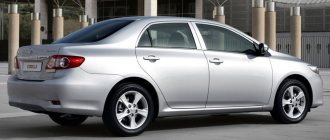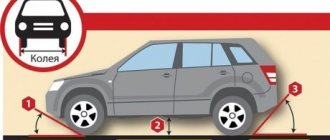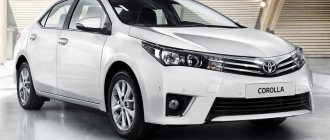Ground clearance (clearance) is the distance between the road surface and the lowest point of the central part of the vehicle. The higher this indicator, the lower the likelihood of damaging the bottom of the car when driving on a road surface of poor quality. The ground clearance of different Toyota Corolla models differs, but is rarely less than 150 mm.
Vehicles supplied to our country are adapted to Russian roads and have increased ground clearance, which allows them to more easily overcome uneven roads and various obstacles. If you compare the photos posted in foreign reviews, you will notice that the Corollas produced for European countries have low wing arches and fit the wheels. At the same time, in cars adapted for our country, even shock absorbers are visible in the clearance.
The ground clearance of various representatives of the Toyota Corolla model range varied depending on the body type, suspension used, and also on the number of drive wheels. Below are the ground clearance indicators of the most popular representatives of the Coroll model range:
- Toyota Corolla E-120 - 160 mm;
- Corolla Fielder CVT - 160 mm in front-wheel drive and 155 mm with all-wheel drive;
- Toyota Corolla Luxel - 170 mm;
- Toyota Corolla Sportivo - 160 mm;
- Toyota Corolla XRS - 145 mm in old models and 135 mm after restyling;
- Toyota Corolla Rumion - 135 mm in front-wheel drive models and 140 mm with all-wheel drive;
- Toyota Corolla 11th generation - 150 mm.
Technical equipment
Models produced in 2012 were equipped with a gasoline and diesel engine. Models were supplied to our market only with a gasoline engine with a volume of 1.3/1.6 liters. You can find cars with other engine options, but such Corollas were not officially supplied to our market. Engines with an increased volume of 1.8 liters are especially popular.
Due to the fact that engines with a well-chosen gearbox are quite economical, they stand out from competitors in the same class. As for the cars supplied to our market, they were equipped with power plants with the following characteristics:
- Volume 1.3 liters with a power of 101 hp, gasoline consumption 6 liters per hundred;
- Volume is 1.6 liters with a power of 124 hp, gasoline consumption in the mixed cycle is 7 liters.
Each of the engines can be equipped with a 6-speed manual transmission or a 4-speed automatic. When driving a car with a manual transmission, it becomes more dynamic.
The overall dimensions of this model are as follows:
- Length 4.5 meters;
- Width 1.7 meters;
- Height 1.4 meters
- Ground clearance (Clearance) 15 centimeters.
In terms of safety, the car is equipped at a good level and has:
- Airbags 6 pieces;
- Anti-lock system;
- Traction control;
- Exchange rate stability;
- A system that distributes forces during emergency braking.
Thanks to the reinforced body, the car passed all the various crash tests perfectly, and received the maximum number of stars almost everywhere.
All generations of Toyota Corolla
2019 – today
XII
2017 – 2018
XI restyling
2012 – 2016
XI
2010 – 2012
X rest.
2006 – 2010
X
2002 – 2007
IX
Fast passage
- A Acura
- Alfa Romeo
- Alpina
- Alpine
- Aston Martin
- Audi
- Aurus
- B Bajaj
- Bentley
- BMW
- Brilliance
- Bugatti
- BYD
- C Cadillac
- Caterham
- Changan
- Chery
- CheryExeed
- Chevrolet
- Chrysler
- Citroen
- Daewoo
- Daihatsu
- Dartz Motors
- Datsun
- Detroit Electric
- DFM
- Dodge
- FFAW
- Ferrari
- Fiat
- Ford
- Foton
- G GAC
- GAZ
- Geely
- Genesis
- GMC
- Great Wall
- GTA Motor
- H Hafei
- Haima
- Haval
- Hawtai
- Hennessey
- Honda
- Hummer
- Hyundai
- I Icon
- Infiniti
- Iran Khodro
- Isuzu
- JJAC
- Jaguar
- Jeep
- K KIA
- Koenigsegg
- L Lada
- Lamborghini
- Land Rover
- Lexus
- LIFAN
- Lincoln
- Lotus
- Luxgen
- M Marussia
- Maserati
- Maybach
- Mazda
- Mazzanti
- McLaren
- Mercedes-Benz
- MG Cars
- MINI
- Mitsubishi
- N Nissan
- Opel
- P Pagani
- Peugeot
- PGO
- Porsche
- Proton
- Q Qoros
- Ravon
- Renault
- Rolls-Royce
- S Saab
- Samsung
- SEAT
- SeAZ
- Skoda
- Smart
- SsangYong
- Subaru
- Suzuki
Go
The Toyota Corolla debuted in 1966. The model of that time was rear-wheel drive and had a longitudinally mounted engine. The designers of the Corolla series maintained this principle until 1984, when the first modification of the Toyota Corolla, already in its fifth generation, with front-wheel drive, was released. From 1966 to 1977, the model was produced in five body versions: three- and five-door hatchback, station wagon, liftback and sedan. The fifth generation retained rear-wheel drive only for the station wagon and three-door hatchback. And the sixth generation, released in 1987, was already completely front-wheel drive. Until 1992, Corolla was equipped with four options of gasoline engines: carburetor and injection power units with a volume of 1.3 and 1.6 liters. The seventh generation era began in 1992. Manufacturers have lengthened the car, making it more spacious. In May 1997, the eighth generation of Toyota Corolla debuted. The main achievement of this modification in Europe was the title “Car of the Year”. The next version of the car was released in 2001, and the tenth generation anniversary was released in 2006. The 2007 Toyota Corolla is available only as a sedan, and the hatchback has become a separate model – the Auris.
Interior
The interior of the Toyota Corolla is quite modest and cannot boast of anything special, but at the same time, all controls are located on the front panel and have well-thought-out ergonomics.
Each of the possible configurations includes a modern audio system, the only difference being the number of installed speakers. In the back row, passengers feel quite comfortable, since there is enough space there, plus there is no tunnel in the middle of the floor.
It is also worth highlighting the sound insulation, which is performed at a high level; it is also worth highlighting the trunk, which has a volume of 450 liters; when the row of rear seats is folded, its volume increases.
Methods for adjusting and changing ground clearance
The standard ground clearance is often insufficient for normal operation of a car, especially in the absence of a normal road surface. To increase ground clearance, you can carry out a so-called body lifting, which may include installing special spacers and replacing chassis elements. This way you can raise the body a few centimeters. Excessive lifting of the machine can lead to loss of control, especially at high speed, as well as rapid wear of some of its parts.
Many Corollas are equipped with a special type of suspension that regulates the distance to the road surface - air suspension. Its design contains special elastic pneumatic elements that allow you to change the level of the body relative to the road surface. The use of such a device can eliminate the need to increase ground clearance by modifying the suspensions and installing special spacers.
Body and dimensions
The body of the Corolla is dominated by smooth lines and transitions without sharply defined corners. It looks quite dynamic and at the same time solid. The overall picture is visually complemented by massive bumpers.
The car has standard dimensions for models in its class. The length of the body is 4545 mm, the width of the car is 1760 mm, and its height is 1470 mm. Ground clearance (ground clearance) is 150 mm, which, in principle, is not bad, but sometimes it’s worth thinking about before leaving the city on a country road.
Konstantin, car ownership experience - 3 years
Over the course of my life, I have driven many brands, ranging from a “penny” to an Audi A8 D2. After my last car I wanted something economical and reliable. I talked to my friends at the service station, they recommended a Toyota Corolla 1.6 with a manual transmission. After some searching, I purchased a 2012 copy.
I have already driven 96 thousand km in this car, and nothing negative has happened to the car. No major repairs, just changed consumables, front stabilizer bushings, front brake pads, and that’s it.
The hood is light and small. It’s a pity that it is fixed on an ordinary iron stand, and not on gas supports, but this is a trifle, because the main thing is what is under it. An atmospheric engine, the chain and spark plugs of which can operate for 200 thousand km, and this is stated in the manual. Basically, all you need to do with the engine is add oil.
By the way, such a unit is very demanding on its quality, so I advise you to fill it with good quality.
In the city it consumes about 9 liters of gasoline per hundred, and on the highway - around 6.5.
The upper plastic of the dashboard is really soft and falls under your finger, but it is hard in the middle and below. It doesn't make any sounds when driving, only if you move it with your hand. I noticed that the interior creaks a little only when it’s cold, and if you warm it up, you don’t hear any extraneous noise from the panels at all.
The seat heating is inconvenient - you have to reach through the lever to reach the button.
When I started this car for the first time (I drove a Priora before), I didn’t immediately realize that the engine was working. Firstly, it was quiet, and secondly, practically no vibrations were transmitted. The engine becomes audible only after 3 thousand revolutions.
I didn’t like two things: ice hangs in the areas where the trunk opens. Moisture always rolls off the glass and gets into the joint between it and the trunk. It happens that there is a very strong creaking there in winter. Condensation is dripping from the interior lamp. I read reviews about the 2012 Toyota Corolla, where they wrote that this problem can only be cured by gluing the roof, but I don’t want to take on that.
What is this car?
Europe first saw a modification of this model in 2007. It should be noted that the hatchback of this model received its own name - Auris. The tenth version of this model, the anniversary one, greatly transformed its entire appearance. She gained more solidity and style.
The standard basic equipment of this model is called “comfort”. It is understood that this option will have air conditioning and front windows. Headlight glass washers are installed in the front bumper. The front seats, as well as the front mirrors, are equipped with heating systems. The car is equipped with central locking and an immobilizer. There is a modern car radio.
The equipment called “Elegance” rises somewhat higher. In it, to everything that was listed earlier, a power window is added to the rear doors, which operates in automatic climate control mode. The radio gets additional speakers. The steering wheel is covered in leather and equipped with keys that control the audio system and front fog lights.
The richest “prestige” equipment brings the car to the level of a high level of equipment. Such models are equipped with alloy wheels, light and rain sensors. A button to start the engine appeared in the cabin. Not without installing cruise control and an electrochromic rear view mirror.
READ MORE: Technical specifications of the 2010 Toyota Corolla
The swift appearance of this model is enhanced by its length, which is 130 mm longer than its predecessor. Starting from 2007, it began to be produced 50 mm wider, and the roof pillars became narrower. All this taken together made her interior more spacious and comfortable.
The model's interior received wider doorways and a new design of car seats, which added even more comfort to the car. The interior is decorated only with high-quality materials. Two color types of finishing are used, these are dark gray and light beige tones.
The luggage compartment of the Toyota Corolla, which was produced in 2007, 2008 and 2009, has been significantly expanded. The cabin is equipped with several places to store small items.
Transmission Safety Features
| Corolla E180 characteristics, ground clearance, trunk volume, tank volume, dimensions, consumption According to reviews from owners of such cars, the real fuel consumption of the Toyota Corolla per 100 km is 6.5-7 liters in the city, 5.7 in mixed driving and 4.8 l in the suburban cycle. Yes, it is the injector nozzle, due to the use of dirty fuel or fuel with water, as well as due to ordinary aging or wear, that can smoothly pass into such a state that its mechanical part, the needle and seat, begin to leak excess fuel in the position when the injector should be closed. |
| We drove 3000 km on the new Toyota Corolla. We count the costs and draw conclusions: airiness of the cooling system; malfunction of the radiator. Well, in extreme cases, this, however, has only occurred a few times; an error in the computer itself. Similar changes have occurred, and inside we are talking about a slightly unusual plate of a multi-layer front panel, made in a more modern style. |
Lada Vesta – color “Metallic Angkor”
Angkor is a chocolate tone, which is decorated with a metallic gray shade. Under the sun's rays, Angkor turns to a golden, yellow color. Looks great in cloudy weather, the car turns brown. Pros. It shimmers beautifully and looks bright and stylish in any weather. Minuses. The coverage is quite rare; there is an additional payment of 12 thousand rubles.
Reviews
Artem: “I’m not delighted with the color after I looked at it in reality, and not in photographs. For the Lada Vesta, the blue color is much more suitable, and a black car also looks better.”
Roman: “Very deep tone - it seems like a chameleon. Constantly changing, depending on the time of day, weather, lighting.”
Olga: “The car looks bright, but not vulgar - that’s what I’ve been looking for for quite a long time. At first I considered a silver Lada Vesta or a Phantom, but still settled on brown. Very beautiful"
The heart of the compact: characteristics of the Toyota Yaris in all kinds of technical modifications
The European line of power units includes four units:
- 1.4-liter turbodiesel;
- 1L petrol engine;
- 1.33-liter unit running on high-octane fuel;
- hybrid.
Features of the liter power unit
The base unit that consumes the 95th is unique: the block includes three cylinders arranged in a row. A twelve-valve head is connected to it, in the intake camshaft pulley of which the actuator of the VVT-i intelligent gas distribution system is installed. Only a five-speed “mechanics” is supposed to use the useful energy of the 1KR-FE installation.
The strength of the technical characteristics of this modification of the Toyota Yaris is its efficiency - 5.0 l/100 km in mixed mode. In the power and dynamic fields, the motor has nothing to brag about:
- the peak of a modest 96 Nm occurs at 3,600 rpm;
- power is mediocre: 69 hp;
- the result of acceleration of 1,100 kg to “hundreds” is beyond modern standards: 15.3 s.;
- speed limit - 155 km/h.
Potential value 1.33
The design of this gasoline engine is more stereotypical: four cylinders and a DOHC valve head. The hardware is equipped with a Dual VVT-i system, which already includes two actuator clutches. The 1NR-FE is available with both a six-speed manual transmission and a V-belt variator MultiDrive S, the seven stages of which are able to overcome the monotonous sound when the selector is switched to manual mode.
Performance indicators of the 1.33-liter device – a classic in the B segment:
- maximum thrust - 125 units at 4,000 rpm;
- peak power – 99 hp;
- maximum design speed – 175 km/h.
The low ground clearance and manual transmission allow the Toyota Yaris to accelerate to “hundreds” in a quite acceptable 11.7 seconds. Despite the modest 5.5 l/100 km, the bunch has the largest appetite in the Yaris family circle. According to the passport, the two-pedal version is less dynamic, but more economical: 12.6 s. up to “hundreds” and 5.3 l/100 km.
Diesel evolution
The solid propellant is surprisingly the most advanced in the small car company community. The eight-valve 1ND-TV turbodiesel is equipped with a modern common rail injection system and works only in tandem with a six-speed manual transmission. Dynamics, power and efficiency are in the best proportion here:
- traction active within 1,800-2,800 rpm is 205 Nm;
- peak potential: 90 hp;
- fuel consumption per 100 km in the combined cycle: 3.9 l.;
- shot duration up to “hundreds”: 10.8 s.;
- maximum speed: 175 km/h.
Compact hybrid
The electric-gasoline version presented to Europeans is made in the best traditions: the electric motor, e-CVT variator and gasoline engine are arranged according to the series-parallel Hybrid Synergy Drive principle, known from the experimental Prius hybrid. The nickel-metal hydride battery capacity of 6.5 Ah allows the car to travel 5 km at a speed of no more than 50 km/h exclusively on electric power (the internal combustion engine is completely turned off).
In terms of its technical characteristics, the Toyota Yaris hybrid breaks economy records: 3.5 l/100 km in the combined cycle. Other indicators are also acceptable:
- total power is 100 hp. (75 hp + 25 hp);
- total thrust is limited to 111 Nm, realized at 3,600-4,400 rpm;
- a jerk to “hundreds” is possible in 11.8 seconds;
- the maximum is outlined at 165 km/h.
Toyota Corolla tank volume: what kind of gasoline to fill and how many liters
Fuel tank volume - experiment
https://youtube.com/watch?v=kDsZ23eUKGc
Corolla Verso year Toyota Corolla Station Wagon These cars had tanks with a capacity of 50 liters until a year old.
The volume of the fuel tank is set by the manufacturer in accordance with certain vehicle parameters.
And all this together made the car look much more prestigious. Thanks to this system, you can not only listen to radio waves, but also play CDs.
And today it's time to find the legend again. The fashionable Corolla has returned, bolder and more confident than before.
Starting with the alluring front grille and clean body lines that flow smoothly into the powerful rear end of the car.
This superb sedan looks truly elegant and stunning. Amazing comfort of Toyota Corolla In the new Toyota Corolla, you will not only have the best design around you. Carefully selected materials and sophisticated trendy elements of modern decor.
For example, the instrument panel has glossy black details and blue backlighting that highlight the panel. The interior of the cabin inspires calm.
Answers (1)
In addition, this car will offer you the largest legroom in its class, which also includes space for rear passengers. Toyota Tundra - a new generation full-size pickup truck Modern precision electronics Every user can discover a completely new Toyota Touch information and entertainment system!
It is equipped with a color screen with a sensor and a diagonal of 15.5 cm. Thanks to this system, you can not only listen to radio waves, but also play CDs.
It is equipped with a 3.5 mm jack and a USB input for the necessary connection of various devices. Among other things, you will also be able to connect your phone via Bluetooth. New Exterior The new Corolla also features a refreshed exterior design. It is slightly lower in height than the previous model, but its wheelbase is wider.
The Keen Look and Under Priory designs have been redesigned, bringing more attention to the car's upper grille. Any deviation reduces the maximum volume, since an air plug appears at the top of the container.
Toyota Corolla 2012 1.33 Review and test drive! Part 1
Fuel tank volume The Toyota Corolla E is no exception. For cars of the series, or year, the manufacturer installed a fuel tank into which you can fill 55 liters of unleaded gasoline with an octane number of 92. The same tank is also installed on the series, which belongs to the previous generation. Gas tanks with a smaller volume were installed only on early releases of the Toyota Corolla.
The tank volume of the Toyota Corolla may be larger, up to 60 liters, but this only applies to some station wagons with high-power engines, for example, the Toyota Corolla Spasio, the production of which was discontinued in the city. What gasoline to fill in? As practice shows, the engines used in the Toyota Corolla are including volume 1.
Without any consequences, they allow the use of AI 92 gasoline, as recommended by the Corolla passport. One of the mandatory conditions is to use exclusively unleaded gasoline, since refueling with anti-knock additives greatly reduces the service life of the catalytic converter.
What should be the minimum capacity of the fuel tank of a new car? In order not to reduce the usable capacity of the car body, automakers calculate the average mileage of a car at one gas station and, based on these data, determine the minimum volume of the gas tank. Thus, the more economical the engine, the less fuel needs to be poured for the same mileage, and, conversely, with equal capacities, the mileage of a car with an engine, for example, is 1.
Increased oil consumption: Engine characteristics
| 1ZR-FE 1. 6 16v Dual VVTi 120/125 l. c - Toyota engine (Toyota Corolla): characteristics, reliability, sores, service life, review, reviews and maintenance Now let’s imagine that our temperature sensor tells the computer when the engine is fully warmed up that the engine is still a little cold, that is, it shows a resistance of 500 or more Ohm. During serial production of the Toyota Corolla E150, more than 12 modernized generations and restyling versions are known; the power potential of the car and Japanese quality allowed the car to become popular in all countries of the world. |
Steering • And the design has acquired new characteristic motifs - an abundance of lines and angles, elongated eyes of the headlights, as well as chopped-looking stern lights.
